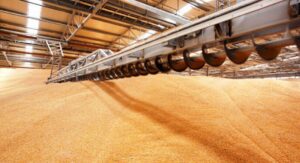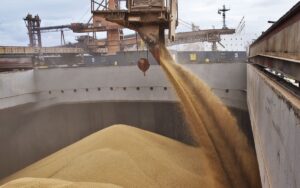
Romanian and Ukrainian Agriculture Ministers Florin Barbu and Minister of Agricultural Policy and Food Nikolai Solsky have agreed on a new strict mechanism that will allow four types of grain to be imported to Romania again. The new system will require Ukrainian and Romanian farmers to obtain licenses, the Romanian newspaper Europa Libera Romania reported.
“Export licenses for Ukrainian companies will start in 30 days. During this time, Romania will also create a clear import licensing procedure for Romanian farmers and processors,” the publication quoted a Romanian minister as saying.
Another agreed rule is that imports are carried out only by farmers and processors, not by intermediaries, the sources say.
“A farmer who wants to import, for example, 1,000 tons of sunflower seeds from Ukraine must prove that he does not have that amount and that his animals cannot live without it,” a source close to the talks between the ministers explained to the newspaper.
Romanian authorities will check the stocks of farmers who ask to import grain from Ukraine.
Another condition is obtaining a quality certificate. The farmer will have to take a sample of the imported goods to the National Veterinary and Food Safety Authority (ANSVSA), where he will receive a certificate stating that the goods are of high quality and do not contain banned pesticides.
The licensing system for grain exporters/importers will be introduced within 30 days.
Barbu said that Kyiv will coordinate Ukraine’s proposal to license exporters with each of the five European countries that have banned imports of Ukrainian wheat, corn, sunflower and rapeseed since May.
As reported, the Ministry of Agrarian Policy and Food of Ukraine held talks with the relevant ministries of Slovakia, Poland, Hungary and Bulgaria, which are studying the Ukrainian action plan and preparing comments on it. Next week, the next stage of Ukraine’s negotiations with neighboring countries will take place.

The number of economic discussions will increase as Ukraine approaches EU accession, and they will mainly concern agriculture, as 40% of the legislative norms that need to be harmonized relate to the agricultural sector, said Mykola Solsky, Minister of Agrarian Policy and Food.
“We need to understand that as we get closer to (Ukraine’s) accession to the European Union, the number of economic discussions will increase. We need to develop immunity to them, be smart and pragmatic,” he said on the air of the United News marathon.
The minister also noted that this year Ukraine received a list of legislative norms from the EU that need to be prepared and changed, and 40% of everything that needs to be adapted to join the EU is related to agriculture and food.
Solsky emphasized that in recent months, Ukraine has for the first time faced the need to defend its economic position to neighboring countries. “This is the first but not the last economic discussion,” he added.
The minister also emphasized that the grain dispute with neighboring countries is the first precedent for Ukraine that has caused such an emotional reaction among Ukrainian society and politicians.
“I propose to treat this as if we have taken half a step to the last line before joining the European Union. When we become a member of the European Union, it will always be like that. This is normal according to the rules of the European Union. This is a democratic association (…) This is a process that we will obviously go through many times,” the Minister of Agrarian Policy said.
Answering a question about the possible escalation of emotions around Ukrainian agricultural exports during the EU accession, Solsky said that there will definitely be such discussions, but “we should not be afraid of them, but should immediately prepare, learn something and take into account something.”
According to the minister, the work at the European Commission level over the past six months has shown that this association regularly holds meetings of agricultural ministers, where discussions are constantly taking place.
“Each state has its own farmers, its own processors, its own interests, which it considers national. They sometimes go against the opinion of other members of the European Union. (…) If we want to be a member of the European Union, we need to be ready to defend our interests publicly, sometimes not publicly,” the minister explained.
As reported, during the week, Solsky held telephone talks with the agriculture ministers of Romania, Bulgaria, Slovakia, Hungary and Poland to discuss the details of the introduction of stricter controls over the export of Ukrainian wheat, rapeseed, sunflower and corn to these countries after the European Commission lifted restrictive measures. Ukraine is obliged to provide written explanations to the neighboring countries on the implementation of the proposed procedures. Negotiations will continue next week.

President of Ukraine Volodymyr Zelenskyy has proposed creating grain hubs in African ports, the president’s website reports.
“Ukraine offers very clear actions. To prevent any shocks to the global food market, we can create hubs for millions of tons of grain per year in particularly sensitive areas, such as African ports,” the press service quoted Zelensky as saying during the Sustainable Development Goals summit.
According to him, negotiations have already begun on such opportunities. This will help prevent any shocks to the global food market.
He noted that Ukraine will never abandon its role as a guarantor of global food security: “No one expected us to be able to push the Russian fleet out of our Black Sea waters and give more space to the Black Sea Grain Initiative and the humanitarian initiative Grain from Ukraine. The results are really impressive.”
“Ukrainian food exports have reached the shores of Algeria, Djibouti, Egypt, Kenya, Libya, Lebanon, Morocco, Somalia, Tunisia, Bangladesh, China, India, Indonesia, Malaysia, Sri Lanka, Thailand, Vietnam, Oman, Pakistan, Turkey, Yemen and other countries. From transit ports, our products were delivered to Ethiopia and Sudan,” the President emphasized.
According to him, the total amount of food is 32 million tons. This is 32 million tons less chaos.
“I thank all those leaders who supported our export programs. Thank you, friends! We have done it. And nothing prevents us from achieving much more ambitious goals,” Zelensky added.

Croatian Prime Minister Andrej Plenkovic said he does not intend to allow Ukrainian grain to enter the country’s domestic market, Politico reported on Tuesday.
“Croatia’s position and desire is that we are a transit country, not a country that will receive a huge amount of Ukrainian grain, which is cheaper than ours,” Plenkovic said.
According to him, imports of such products would lead to the fact that “our farmers would be in trouble.”
On September 15, the European Commission announced the termination of restrictive measures on the export of Ukrainian grain and other food products to the EU. Later, the authorities of Poland, Hungary, and Slovakia announced their own bans.

On Sunday, the European Commission called on Poland, Hungary and Slovakia to be constructive after they unilaterally announced that they would extend the ban on grain imports from Ukraine despite the Commission’s decision to end the ban, Reuters reports, citing a European Commission spokesman.
“We are aware of statements by some member states regarding unilateral measures. It is now important that all countries work in a spirit of compromise and engage in constructive cooperation,” the Commission spokeswoman said.
According to her, Brussels is now focused on “putting in place and making work the new system that has just been announced.”
In particular, Reuters reports that a meeting with representatives of all interested EU countries will be held on Monday to discuss the issue of Ukrainian grain imports in more detail.
The news agency notes that Ukraine was one of the world’s leading grain exporters before Russia’s invasion in 2022 reduced its ability to deliver agricultural products to world markets through Black Sea ports. Since then, Ukrainian farmers have relied on grain exports through neighboring countries.
However, the influx of grains and oilseeds to neighboring countries has affected the incomes of local farmers and led governments to ban imports of agricultural products from Ukraine.
As reported, the ban on the export of wheat, barley, rapeseed and sunflower seeds from Ukraine to Poland, Hungary, Slovakia, Romania and Bulgaria, introduced on May 2 for the period until June 5, was extended until September 15.
On Friday, September 15, the EU allowed the ban to be lifted after Ukraine promised to take measures to tighten export controls to neighboring countries.

Romania is waiting for Ukraine to submit an action plan for effective measures to control grain exports “to prevent market distortion,” which Ukraine promised to submit by the end of Monday, September 18, according to a press release from the Bucharest government, local media reported on Friday evening.
The executive’s statement comes after the European Commission on Friday decided to lift restrictions on Ukrainian grain imports in five countries, including Romania, but asked Kyiv to develop a plan for effective measures to control transportation.
“Depending on the Action Plan presented by the Ukrainian side, the Romanian government will decide on appropriate measures to protect Romanian farmers,” the statement said.
“The government is in constant contact with the European Commission and the Ukrainian side to ensure that the new mechanism for restricting imports of Ukrainian products proposed by the EC prevents distortion of the markets of EU member states,” the statement said.